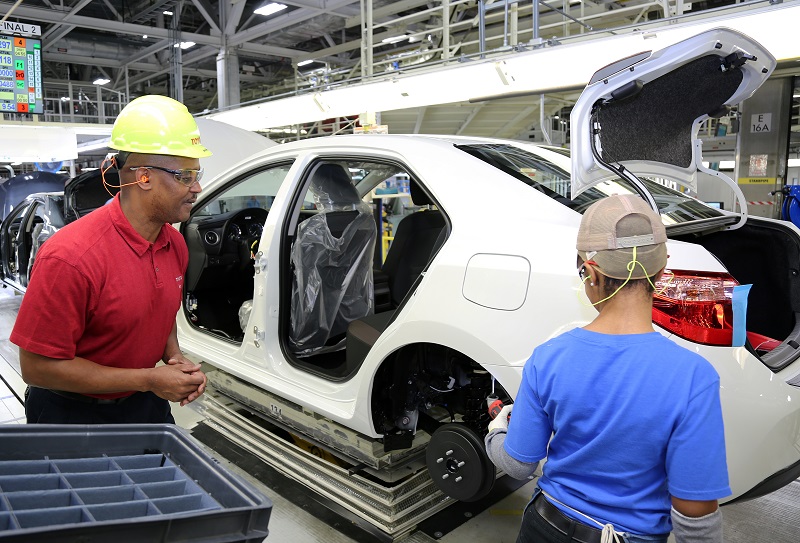Toyota executive Terri Von Lehmden wants to turn the automotive industry on its ear – one job at a time.
Like many in the business, Von Lehmden sees an industry on a path toward tremendous change through future mobility and its potential to enrich and ease everyday life. But she also sees a very specific talent crunch, nagging misconceptions about the industry and, perhaps surprisingly, diminished passion for the business.
“We might have, in some cases, lost it a bit,” says Von Lehmden, vice president-Human Resources, Transformation & Strategy, at Toyota North America.
Von Lehmden thinks the industry can reignite that passion and dispel those misconceptions by re-engaging employees, taking new approaches to hiring, bringing more women into the fold and using alternative tools such as social media to tell the industry’s story and lure fresh talent.
“The team members want it,” she tells Wards in an interview. “They want to develop themselves. They want to make change, not only for themselves but they want to impact change for the organization.”
Inability to affect change in an organization can lead to attrition, Von Lehmden says, citing a PwC survey showing 74% of U.S workers do not think they are achieving their potential and crave development. She suggests partnering with employees and shedding legacy business practices and attitudes.
“When you drive that idea of investing, and a willingness to skill up and develop your folks, you’re reaching a different level of engagement, which is going to drive not only loyalty but also spark passion,” Von Lehmden says.
For example, virtual reality tools could be used to remotely solve an assembly-plant issue instead of dispatching a team of engineers to the factory, as is usually the case, she offers. It would decrease travel time and increase the time spent on innovations to drive the industry’s transformation. Perhaps more importantly, it also would strengthen employee loyalty.
“You’re able to work side-by-side with maybe the shop floor team members to solve the problem, so they are empowered and engaged,” says Von Lehmden, who grew up a car nut in an auto industry family before a 25-year career with stops at the former DaimlerChrysler and Honda before joining Toyota, where she has worked the past 17 years.
“There are many other examples in other business practices, but as an industry we must continue to look to leverage technology differently and break some molds,” she says.
Toyota says it has committed to providing 200,000 workforce training opportunities over the next five years with apprenticeships, work-based learning initiatives, retraining, on-the-job training and other educational programs.
Disengaged employees are costly, Von Lehmden notes, to the tune of about $600 billion in lost productivity, according to one estimate. Companies with engaged employees see 233% greater customer loyalty and 26% more revenue, another study shows.

Engaged employees more loyal, likely to become brand ambassadors, Von Lehmden says.
Challenging the Status Quo
Von Lehmden has shifted Toyota’s talent management to a customer-centric approach that puts the team member, or employee, first. The automaker also now asks at every turn whether long-standing processes remain acceptable. It makes the employee a powerful brand ambassador, she says, which, in turn, attracts new talent to the organization.
“Is it acceptable for you to wait four days to get a response on an e-mail you sent us about your resume, or about the interview you had,” she says. “We’re turning those previous processes on their head by asking, ‘What would the customer want?’”
In addition to challenging the status quo, new Toyota cultural priorities include thinking innovatively, making timely decisions, growing the capabilities of its workforce and collaborating across boundaries.
As its businesses have come together, Von Lehmden says, Toyota has seen several improvements, such as its ability to change its product mix more quickly as a result of customer feedback. Heightened employee collaboration is bringing new ideas and innovation to market sooner.
Von Lehmden thinks the customer-centric approach works particularly well at Toyota because respect for people is a pillar of the Toyota Way, a set of principles and behaviors underpinning the automaker’s managerial approach. The other pillar being kaizen, or continuous improvement.
“I will say, having been at other OEMs, there’s a secret to the Toyota DNA: Respect and continuous improvement being the two pillars of every decision we make,” she offers.
The average tenure of a Toyota employee is 13 years compared to a national average of 4.6 years, according to the Bureau of Labor Statistics, suggesting Toyota employees enjoy their workplace. But when the automaker moved its U.S. operations to Texas from California two years ago, Von Lehmden shook up its recruiting approach in a market where the automaker predominately was known as a manufacturer or the dealership down the street.
“If we were going to compete, we needed to make sure folks understood us as an organization,” she says, counting off the myriad professional opportunities at an automaker. “We had a pretty big social-media push, a digital strategy, because what we found was, we’re a pretty humble company when it comes to talking about ourselves.”
Toyota shared with candidates who it was as a company, what it stands for and how people can build a career with the automaker. It launched a new employer brand across all its job channels leveraging social media, events and advertising to tell candidates about its leadership and culture.
Personal storytelling also became an element of the recruiting process, especially when targeting women and other diverse candidates, through online videos or sending diversity and inclusionary ambassadors directly into the community to engage potential employees.

Dispelling industry misconceptions will make automotive more attractive to women, Von Lehmden says.
A Workplace Reflecting the Customer
Hiring more women into an industry where they represent just 25% of the work force is another item high on Von Lehmden’s agenda, and perhaps for good reason: Women control 65% of personal wealth, she says, and influence 85% of consumer purchasing decisions. They are 62% more likely to share branded content, she adds, which makes them excellent brand ambassadors. Woman also will make up 60% of the American work force by 2028.
“We’re not the first choice. When (women) get out of college, hardly anyone says, ‘I want to go work for an auto company,’” Von Lehmden says, suggesting the industry must change perceptions of its dingy factory floors and more actively portray it as a multi-faceted business.
“The (Chrysler) Toledo assembly plant was my first assignment. That was old,” Von Lehmden recalls. “Go in there now and you could practically eat off the floor. Female perceptions have not changed with that. We haven’t done a good job telling that story.”
To draw more interest from women, as well as an entire new generation of college graduates, the industry also must double down on STEM activities with grade schoolers and connect the business with a higher sense of purpose than just building and selling cars, she says.
“As an industry, while it has been the backbone of this country for many, many years, we have to connect it to how we’re going to do more than move you from point A to point B. We are going to help you over the course of your life,” Von Lehmden says. “There’s such an opportunity for us to tell that story. That’s a powerful part of today’s auto industry.”





